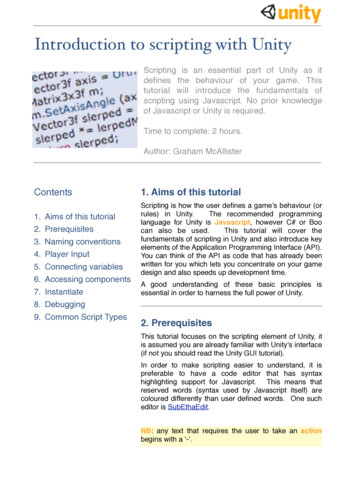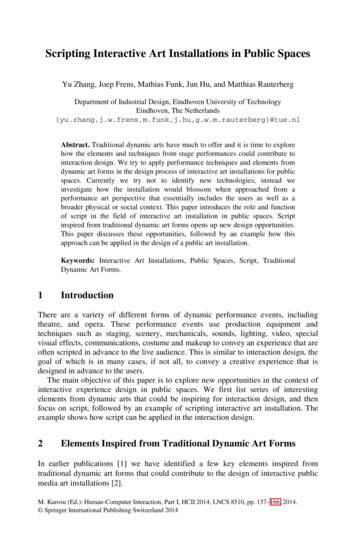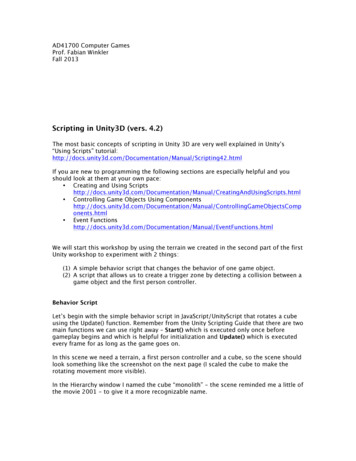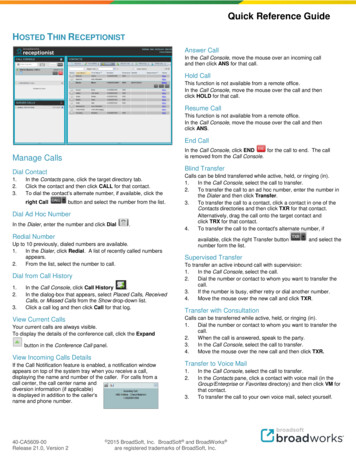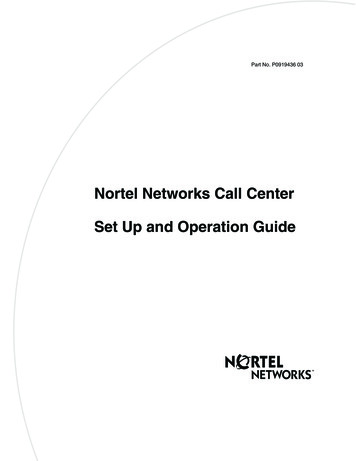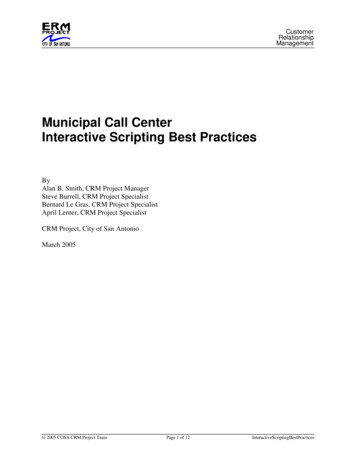
Transcription
CustomerRelationshipManagementMunicipal Call CenterInteractive Scripting Best PracticesByAlan B. Smith, CRM Project ManagerSteve Burrell, CRM Project SpecialistBernard Le Gras, CRM Project SpecialistApril Lerner, CRM Project SpecialistCRM Project, City of San AntonioMarch 2005 2005 COSA CRM Project TeamPage 1 of 12InteractiveScriptingBestPractices
CustomerRelationshipManagementTABLE OF CONTENTSEXECUTIVE SUMMARY . 3THE 3-1-1 CALL CENTER. 4INTERACTIVE SCRIPTS . 5INTERACTIVE SCRIPT GUIDELINES . 8CONCLUSION . 12 2005 COSA CRM Project TeamPage 2 of 12InteractiveScriptingBestPractices
CustomerRelationshipManagementExecutive SummaryIn addition to the well known “9-1-1” emergency number, many cities have implemented “3-11” to handle non-emergency police calls or city service calls. To increase the quality of citizeninteraction and increase the rate of correct problem identification, the City of San Antoniocreated interactive scripts for its 3-1-1 Call Center agents. Interactive scripts are text that appearon an agent’s computer screen that help guide the conversation so that the right questions areasked and the right data are gathered to correctly identify the citizen’s need and create the correctservice request.However, with the development of interactive scripts, there was a tension between the CallCenter, which sought to minimize call times, and the City departments, which wanted more data,requiring longer scripts and leading to longer call times. The solution was to devise andimplement uniform script standards regulating (1) syntax, the order, grammar, and language ofthe text, (2) structure and flow, the organization and arrangement of the script modules, and (3)levels, the number of text questions or information (i.e., the “depth” of the script.)In one example, by enforcing these standards on a script involving the problem of a fallen treeblocking a street, not only was the script readability improved, but it was reduced from sevenlevels to five, reducing the average call time by 16 seconds, and still providing the Citydepartment with the information needed to correct the problem. 2005 COSA CRM Project TeamPage 3 of 12InteractiveScriptingBestPractices
CustomerRelationshipManagementThe 3-1-1 Call CenterIn addition to the well known “9-1-1” emergency number, the Federal CommunicationsCommission (FCC) and telephone companies have adopted other three-digit “N-1-1” numbersfor non-emergency purposes. On October 2, 1996, the Police Department of the City ofBaltimore adopted “3-1-1” to handle non-emergency police calls.1 On February 19, 1997 theFCC approved 3-1-1 for nationwide use.2 Since then, many cities have implemented 3-1-1 callcenters to field non-emergency police or city service calls, such as potholes or inoperable trafficsignals.In April 2000, the City of San Antonio implemented a 3-1-1 Municipal Call Center to provide 24x 7 citizen access to City information and services. Since its inception, the Call Center hasexperienced double-digit growth in the number of calls it receives annually. The Call Centerfurther predicts that call volume will continue to grow at approximately 20% annually throughthe next two fiscal years. However, despite the double-digit growth in call volume, budgetshortfalls have prevented the Call Center from appreciably increasing the staffing level of itscustomer service representatives (CSR), or agents. This increasing difference between callvolume and staffing levels threatened the Call Center’s ability to maintain its desired servicelevels.The primary tool for the CSR is a text-based mainframe application integrated with the City’sAnimal Care, Code Compliance, Environmental Services, and Public Works tracking systems.In 2003, the City began a comprehensive effort to create interactive scripts that a CSR could useto guide the call correctly and efficiently without unnecessary talk time. The challenge has beento ensure that these scripts enable the agent to gather enough information to create the rightservice request, but do not unnecessarily extend call times and degrade customer service.Municipal Call Centers have different challenges from traditional business call centers. Businesscall centers are an integral component of the customer management lifecycle model that managescustomers from acquisition to retirement. Business call centers are typically focused oncustomer satisfaction, retention, and profit maximization, and are allowed to provide customerswith varying levels of service based upon predefined standards, such as frequency or sales. Anexample is the frequent flyer program of a typical airline.Municipal call centers do not function under the same customer (i.e., citizen) lifecycle model andcannot tailor its services based upon the money (i.e., taxes) the citizen provides. Every citizenshould receive the same level of service regardless of economic status. Furthermore, unlikeprivate companies, service must be provided even if the citizen wishes to remain anonymous.Municipal call centers are funded by taxes, which may be in decline or subject to politics.Municipal call centers must try to reduce or contain costs without being able to restructure itsoperations towards revenue generating activities.1Mazerolle, Lorraine, et al., “Managing Citizen Calls to the Police: An Assessment of Non-Emergency CallSystems,” Cincinnati, OH, February 14, 2003, pg. iii.2FCC Report No. CC 97-7, Washington, DC, February 19, 1997, http://ftp.fcc.gov/cgb/dro/311news.html. 2005 COSA CRM Project TeamPage 4 of 12InteractiveScriptingBestPractices
CustomerRelationshipManagementInteractive ScriptsDescriptionInteractive scripts are text that appear on a computer screen to guide agents through citizeninteractions by moving through a series of steps. These steps may include questions withpredefined answers, open fields for text entry, business transactions, links to web documents,or any other activities.ExampleThe City is responsible for investigating and correcting the problem of ponding, or standing,water, which is a breeding ground for mosquitoes. However, depending on the location ofthe water, this problem could be routed to one of three different organizations. Not gettingthe right service request with the right information to the right organization is costly to theCity. This simple example follows a small branch of a larger script to properly identify anddiagnose the standing water problem.ParkPonding orstanding waterWhat exactly isthe problem?Where is thestanding waterlocated?Street/SidewalkPrivatePropertyCreate a servicerequest for Parksand RecreationDo you knowwhat caused thedrainage problem?Create a servicerequest for StreetMaintenanceDo you knowwhat caused thedrainage problem?Create a servicerequest for StormWaterEngineeringFigure 1 - Ponding Water Script BranchIf the citizen responds that the problem is in a park, the agent creates the necessary servicerequest for the Parks and Recreation department, along with the pertinent details, such aspark name and location. If the citizen responds that the problem is in the street or on asidewalk, the agent will create a service request for the Public Works-Street MaintenanceDivision including the case of the drainage problem, if known. Lastly, if the citizen respondsthat the problem is on private property, then the agent creates a request for the Public WorksStorm Water Engineering Division. While this process relies upon the knowledge of thecaller, the script flows help to increase the probability of correct problem identification.BenefitsInteractive scripts provide the Call Center with several benefits: 2005 COSA CRM Project TeamPage 5 of 12InteractiveScriptingBestPractices
CustomerRelationshipManagement1. They increase the quality of citizen interactions: The right questions are asked every time. The approach to each caller is uniform. The information provided to each caller is consistent and correct.2. The Call Center agent has a shorter learning curve: Scripts with clear instructions and predefined responses eliminate the need tomemorize dozens of departmental codes and shortens the time to learndepartmental processes.3. They increase the rate of correct problem identification: Scripts guide the agent to identify the correct problem quickly and to create theright service request.Increasing the rate of correct problem identification has an immediate positive financialimpact for the City. For example, the Streets Maintenance Division of the Public WorksDepartment reports that roughly 15% of their pothole service requests are misclassified,costing the division roughly 253,000 per year to send out the wrong crews with the wrongmaterials. Increasing the rate of correct problem identification at the point of service requestcreation reduces costs and increases citizen satisfaction by: Increasing the number of problems solved on first contact.Decreasing the number of required follow-up calls due to insufficient information.The Cost of QualityWhile there are clear benefits from using interactive call scripts, these benefits would benegated if the scripts unnecessarily increased call times and decreased customer servicelevels. In practice, there is a constant tension between the Call Center, which strives toreduce call times and meet its own performance metrics, and the City departments, whichwant as much data as possible to reduce the amount of rework they must accomplish. TheCity needed guidelines for script development to ensure that stakeholder needs were properlybalanced.An important financial consideration for the Call Center is cost per call. For the average Citydepartment, an important consideration is the internal cost of fulfilling a request for service.A misclassified service request is one where the problem identified and received by thedepartment is not correct to actual problem. For example, misclassified or incorrect servicerequests lead to: Increased time and cost of deploying the wrong personnel and wrong equipment tosolve the wrong problem.Increased time and cost of updating, reclassifying, and reassigning misclassifiedservice requests.The potential cost when service requests that impact liability and public safety (forexample, a stop sign down) are not correctly identified, communicated, and addressedquickly. 2005 COSA CRM Project TeamPage 6 of 12InteractiveScriptingBestPractices
CustomerRelationshipManagementA useful model for interactive scripts had to focus on eliminating misclassified servicerequests, thereby focusing on the benefits of getting each service request right the first timeon the first call, yet accomplishing this goal in the shortest time possible on the call. 2005 COSA CRM Project TeamPage 7 of 12InteractiveScriptingBestPractices
CustomerRelationshipManagementInteractive Script GuidelinesThe primary drivers affecting the cost (usually time on call) and quality of interactive script are:1. Syntax – The order, grammar, and language of the text.2. Structure and Flow – The organization and arrangement of the script text modules.3. Levels – The number of text questions or information.SyntaxWhile it is difficult to apply quantitative measures for script syntax, there are sufficientqualitative “tips” that should be applied.1. Involve the end-users (agents) throughout the script development. The agentswill be the ones to communicate directly with the citizen and will bear theconsequences of bad scripts. Experience provides them with tried and tested terms,phrases, and statements that work with the citizens they communicate with. Agentinvolvement generates a greater wealth of ideas during script development, as well asbuilds buy-in and ownership after implementation.2. Write in short, crisp, grammatically correct sentences that are easy for the agentto understand and read. Simple and direct sentences with clear wording havemaximum clarity and impact. Agents will be able to articulate them easily and willnot have to take additional call time to restate and explain the question.3. Drop buzzwords and technical terms in favor of commonly understoodexpressions and concepts. For example, even though it would be apparent andessential information for a Public Works employee, callers typically would not knowthe difference between a pothole and a base failure in the street. Instead, usecommonly understood references. For example, ask the citizen whether the hole inthe street is bigger than the top of a standard washing machine. The answer will tellyou whether the problem is a pothole or possibly a base failure.Structure and FlowOnce the script text has been refined and improved, the order of the text and how the text fitstogether is important.1. Include frequently needed information and provide easy links to the rest. Thescript text should include important information that the agent will need to completethe call quickly. However, too much text will make the script unwieldy and degradethe agent’s performance. Include only information needed on a regular basis (valueadding) and provide quick links to web sites or external databases for any otherinformation that may be needed.2. Simplify the scripts by outlining the call flow and then developing a flow chartshowing all exits and branches. An important tool to manage call structure is a 2005 COSA CRM Project TeamPage 8 of 12InteractiveScriptingBestPractices
CustomerRelationshipManagementprocess flow diagram. A visual illustration of the call flow will show potentiallyunnecessary or complex branches. Use this tool to streamline the call flow andreduce the number of branches where possible. Also, modularize the script intosections to maintain proper organization.3. Highlight key points through text effects, such as bolding and underlines.Breaking up key portions of the text makes it easier for the agent to find andcommunicate information. For example, highlight service level agreements (thenumber of days to complete the request) in bold.4. Standardize citizen responses through pre-determined answers, such aspushbuttons, over free text, when possible. Often, there are points in a call scriptwhere citizen feedback is required. For example, a caller reporting a rabid animalneeds to provide the location and type of animal. The agent can record thisinformation either in free-form text fields or through standardized responsesfunctions, such as drop-downs and pushbuttons. By using standard response tools,where possible, the agent can record the information faster. Furthermore, the datacollected are standard and uniform. Also, by ensuring that the agent cannot progressunless a response is selected, it forces information to be collected preventing gaps inthe ability of the departments to provide the service.LevelsAgent performance is not only affected by the quality and structure of the scripts, but also bythe number of questions asked. In studies, our team determined that each script question, onaverage, translated to approximately eight seconds of call time. Thus, it was important toimplement guidelines on the number of questions asked.Each service requested at the Call Center was measured by the following three factors:1. Frequency – How often is the information or service requested? (Higher frequencyrequests cost more because the City spends more time and resources on them.)2. Criticality – Does it affect matters of liability or public safety? (Higher criticalityrequests usually cost more to complete and the cost of failure is high.)3. Cost – What does it cost the City to fulfill the request?These three factors were measured on a scale of “High,” “Medium,” and “Low.” Table 1below describes the guidelines for each measure. 2005 COSA CRM Project TeamPage 9 of 12InteractiveScriptingBestPractices
calityCostHighRequested dailyMediumRequested less thanonce per day; weeklyPotential for legalGeneral requests,liability for the City orrepairs, or nonissue of public safety;emergency dispatch;must be completed in 24 must be completed fromhours or less24 hours to 14 daysRequires dispatch ofcrew and materials;typically involvesmultiple departments ordivisionsRequires dispatch ofindividual with little orno materials; typicallyinvolves singledepartment or divisionLowRequested less thanonce a week; monthlyInformation requests,studies, estimates, oradditional citizencontact required; canbe completed ingreater than 14 daysRequires no dispatch;typically performed orcompleted by a calltaker onlyTable 1Priority LevelsBased upon the measurements of each factor, requests are assigned a priority of 1, 2, or 3.These priority levels describe the importance to the City of “getting the request right the firsttime” (creating the right service request with zero defects). If criticality is rated High or iftwo or more factors are rated High, then the request is assigned Priority 1. If two or morefactors are rated Low, then it is assigned Priority 3. All other requests are assigned Priority2 (see Table 2).Given the increase in cost and liability to the City, Priority 1 requests justify more scriptquestions and longer call times. Furthermore, Priority 1 requests, by the nature of the servicerequested, typically reflect greater script complexity and more time on the call to get therequired information from the citizen. While it is important and emphasized that the agentshould get every citizen request right, not every request has the same impact to the City andits citizens.Each priority is assigned a “soft” ceiling on the number of questions that may be asked.Higher priority requests are allotted more questions than lower priority requests. Factoring inthe time required for all components of the call (such as a greeting) and the desire to reach anaverage call handle time of 90 seconds, priority 1 requests were allotted six questions,priority 2 were allotted four questions, and priority 3 were allotted two questions (see Table2).It is important to note that these are guidelines and not absolutes. It is possible that adepartment may not be able to complete a request with the defined limited number ofquestions. In those cases where a department needs to exceed the guidelines, it is evaluatedon a case-by-case basis and an agreement is reached between the requesting department andthe Call Center Manager. 2005 COSA CRM Project TeamPage 10 of 12InteractiveScriptingBestPractices
CustomerRelationshipManagementPriorityPriority 1Priority 2Priority 3Standard6 Levels/Questions4 Levels/Questions2 Levels/QuestionsRatingCriticality is High or two or more factors are HighNo two factors HighTwo or more factors are LowTable 2ExampleThe City receives requests to clear fallen trees that are blocking streets. This service isrequested daily (483 requests in 2003) (Frequency High). A fallen tree blocking a street isa public safety concern and must be completed within 24 hours (Criticality High).Finally, it is a service that is performed by a single department and crew (Cost Medium).Since two of the factors are rated high (plus criticality is rated high), this request is assigneda priority of 1 for a total of six questions. Initially, the script consisted of seven levels ofquestions, such as whether the tree was located in a park, whether it was between the curband the sidewalk, and the nature of the safety hazard. Working together, the impacteddepartment and the Call Center Manager were able to eliminate one of the questions andcombine two others. The impact was to reduce the script from seven levels to five, therebyreducing call time by roughly 16 seconds, but still meeting the needs of the receivingdepartment.Additional ConsiderationsIf the scripts are being developed in an application by a technical team, there are two finalpoints to consider.1.Use variables where possible. Depending on the functionality of the system, it maybe possible to insert variables into the script. These variables serve as placeholdersthat will populate and display data from a corresponding table. It is cheaper andfaster to update a single field in one database table than to update multiple scripts.2.Modularize script components. Programmers know the value of modularizingtheir code. Modularization is the process of breaking programs up into reasonableunits. Breaking up scripts into interconnected units has advantages. It allowsmultiple developers to work on the scripts by dividing up work tasks. It allows foreasier maintenance since the developers only have to update one module when aservice changes rather than have to update the same information in multiple scripts. 2005 COSA CRM Project TeamPage 11 of 12InteractiveScriptingBestPractices
e call scripts that guide Call Center agents through their citizen calls provide anenormous benefit in terms of call quality and accuracy. However, if specific and reasonablecontrols are not exercised on the quality, length, and construction of the scripts, the desiredbenefits will be lost due to call quality degradation and excessively long call times. Byemploying the guidelines and standards defined in this case study, Call Centers can ensure thatthey have employed an acceptable balance between cost and quality. 2005 COSA CRM Project TeamPage 12 of 12InteractiveScriptingBestPractices
Municipal Call Center Interactive Scripting Best Practices By Alan B. Smith, CRM Project Manager Steve Burrell, CRM Project Specialist Bernard Le Gras, CRM Project Specialist April Lerner, CRM Proje
